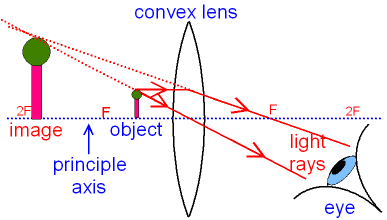
gcsescience.com 28 gcsescience.com
A Convex Lens as a Magnifying Glass.
The type of image
made by a convex lens
depends on how far away the object
is.
The picture below shows how to draw a ray
diagram
for an object that is nearer
to the
lens
than F.
Click
here for a ray diagram for
an object that is further
away than F.
When the object is
nearer to the lens
than F
(less than the focal
length)
a convex lens acts as a magnifying
glass.
What is the Ray Diagram for a Magnifying Glass?
The bottom of the object
is placed on the principle axis.
Two rays of
light are
drawn from the top of the object.
The first ray of light
is parallel to
the principle axis
and therefore
passes through the focal point.
The second ray of light
goes from the top of the object
and passes straight through the centre
of the lens.

Unlike the previous
page,
the rays are
diverging
(moving apart) on the right side of the lens.
The eye looks back along the rays
that seem to have come
from
a point behind the object
where the two rays of light
cross.
This is where you draw the top of the image.
The bottom of the image
is still on the principle axis.
The image
made by a magnifying glass
is virtual, upright
and bigger than the
object.
The image is called virtual because the light rays
never really
go there
(compare this with a real
image).
The virtual light rays are drawn as dotted lines.
The image is called upright
because it is the right way up
(compare this with an inverted image).
The image is bigger than the object
and on the same side of the lens
as the object.
The eyepiece of a telescope
is
a convex lens
used as a magnifying glass.
![]() Links
Waves
Light
Revision Questions
Links
Waves
Light
Revision Questions
![]()
gcsescience.com Physics Quiz Index Lens Quiz gcsescience.com
Home GCSE Chemistry GCSE Physics
Copyright © 2015 gcsescience.com. All Rights Reserved.